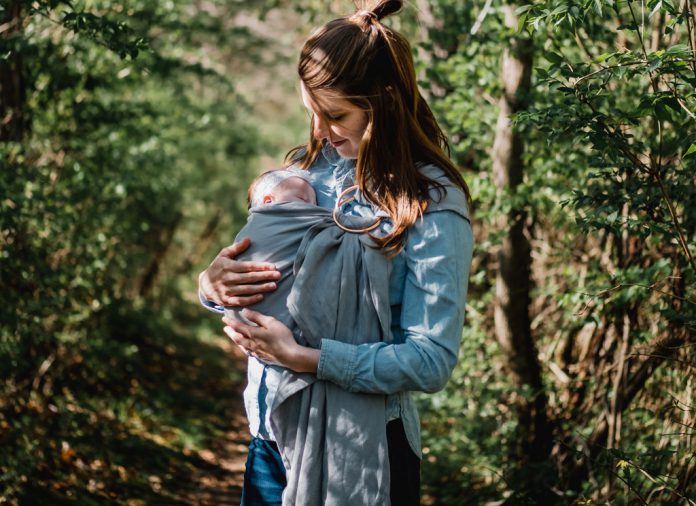One of the questions most new parents have is how to take their baby out and about on their errands. Or even how do they safely bring him home or to the pediatrician’s clinic and so on? One popular option these days is to babywear. But what exactly is babywearing?
We’ve asked Blanche Pennings, a level 3 certified Babywearing Consultant by the Babywearing School in the UK on what parents should know before wearing their baby.
What is babywearing?
According to Baby Wearing International (BWI), babywearing “is the practice of keeping your baby or toddler close and connected to you as you engage in daily activities through the use of one of a variety of types of baby carriers.” Babywearing has been a traditional practice in many cultures as parents carried their children with them at work and it has regained popularity in the past decade. Some closely associate babywearing to attachment parenting, while others do it for more practical reasons.
What are the benefits of babywearing?
According to Blanche, there are many benefits in babywearing both for the baby and the mother or wearer (be it the father, the caregiver, or the grandparent). The most obvious benefit is the convenience of being hands-free or having one hand free to do other things while being able to hold your baby. Other benefits include, but are not limited to:
- Regulation of body temperature and heart rate
- Babies who are held cry less and are thus happier and more content. They experience less stress and fear, making them more secure and confident in themselves
- Babies who are worn experience good growth results (think: kangaroo care for preemies!)
- Mothers who babywear have reduced chances of postpartum depression as the skin to skin contact produces oxytocin or the happy/love hormone which in turn…
- Helps in the production of breastmilk so mothers who babywear have a high success rate for prolonged breastfeeding.
- It is so so convenient! You can be hands-free and still be able to your chores!
- Babywearing speeds up the recovery process from the pregnancy spine back to the pre-pregnancy spine. There are so many benefits! It is really the best thing you can do for your baby next to breastfeeding!
What are the disadvantages (if any) of babywearing?
Blanche says that some parents purchase baby carriers without understanding what they are buying. One must be informed that there are different carriers for different age groups and needs thus it can be expensive if you have to keep buying carriers throughout your babywearing journey. Nowadays, there are carriers which can be used from birth until 45lbs and these are great carriers that are a real bang for your buck.
At what age can a baby be worn?
Blanche says that you can babywear from birth with the proper carrier. Generally, baby carriers that can be used for newborns are safety tested from around 7lbs.
What should moms consider in choosing a baby carrier?
As a babywearing mom herself, Blanche has the following guidelines on choosing baby carriers:
- Who will wear the baby? Will there be multiple users? If so, carriers that have wearer-dependent sizing may not be for you.
- Do you or your baby have any medical conditions to consider? For example, is there a history of hip dysplasia in the family? Do you have spine problems such as scoliosis? If so, you want to make sure your carrier is ergonomic and provides the best support for your back. Please also consult your doctor before babywearing.
- Weather. Is it always hot where you live? If so, a carrier with a mesh panel is more breathable and both the baby and wearer will be much more comfortable as body temperature will never be removed from the equation so you want to consider external factors that can help with breathability.
- Baby’s developmental milestones and readiness. Is your baby ready enough to be placed in a seated position? If not, hipseats should not be used unless with the proper infant inserts or for assistance in cradle carrying.
- Budget. What can you afford? If you cannot afford a safety tested buckle carrier, a sling or wrap might be a good option.
- Lifestyle. What are your daily activities? Are you out all the time? Will you be babywearing exclusively rather than using a pram/stroller or doing a mix of both? If exclusively babywearing, something that you can be comfortable with even after long carries is important. Comfort is subjective thus it is always best to do a fit test with your baby. There are so many factors to consider thus the advice of a babywearing expert can save you from buying a carrier that will not suit your needs.
What are the safety tips to keep in mind when babywearing?
Blanche has prepared this quick and easy-to-remember safety reminders on babywearing:
In addition, the International Hip Dysplasia Institute also cautions wearers against narrow-based carriers that interfere with healthy hip positioning. According to them, “the healthiest position for the hips is for the hips to fall or spread (naturally) apart to the side, with the thighs supported and the hips and knees bent.”
How can moms get support on babywearing?
There are several non-brand specific websites out there that promote babywearing and safety tips. You can also join support groups like Babywear Because You Care PH, which Blanche founded herself, or simply set a 1:1 or join group session with her!
Join our MomCenter Community on our Facebook page and Facebook group for more insights on motherhood and parenting.





